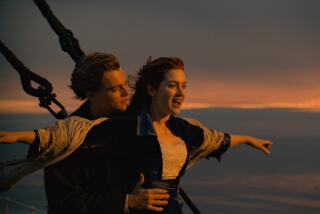Inside the Titanic: Robot Records Its Ghostly Secrets
- Share via
NEW YORK — Scientists sent a tiny robot probe four decks deep into the sunken Titanic for the first time Tuesday, shooting color video pictures of a “beautiful chandelier” still hanging 74 years after the fabled luxury liner sank in the North Atlantic.
“It was like landing on the moon,” Dr. Robert Ballard, team leader of the expedition by the Woods Hole Oceanographic Institution and the U.S. Navy, excitedly told his colleagues via ship-to-shore radio early Tuesday evening.
Ballard said he and two other deep sea scientists landed the submarine Alvin on an upper deck of the giant ghostly wreck and maneuvered an experimental remote-controlled video probe, called Jason Jr., from the Alvin through a broken skylight and then down the ornate first-class staircase.
“We went up and landed at the entrance to the grand staircase and flew Jason Jr. down the grand staircase,” Ballard said, according to a tape of the conversation. “We went down about four decks into the ship and went into one of the rooms off the staircase and went right and looked at a beautiful chandelier hanging from the ceiling.”
He called the experience “amazing.”
Navy Cmdr. Mark Neuhart, a spokesman at the institution, said the room’s location was still unclear but could have been the ship’s first-class smoking lounge or an area of the grand ballroom.
Has Three Video Cameras
The 150-pound, lawnmower-sized Jason Jr. shot color video from three high-resolution cameras. The cameras can swivel 170 degrees, and the Jason Jr. can turn a full circle. The probe is connected to the Alvin by a 200-foot-long tether.
Tuesday’s trip marked the start of an 11-day scientific investigation inside the 883-foot-long Titanic, which struck an iceberg on her maiden voyage and sank April 15, 1912. At the time, she was the world’s largest and most luxurious ship and was touted as “unsinkable.”
More than 1,500 people, including some of America’s best-known millionaires, perished in the famous maritime disaster. The ship now rests upright in utter darkness and a half-knot current about 12,500 feet down on the Atlantic bottom and 400 miles southeast of Newfoundland.
Ballard said he and his two colleagues, pilot Ralph M. Hollis and robot-probe operator Martin Bowen, descended in the 25-foot-long Alvin to about 200 meters off the ship’s starboard bow, where the iceberg had cut a 300-foot-long gash.
“We drove in through a debris field,” Ballard said. “There were lots of cups and recognizable debris.”
The scientists then maneuvered the Alvin “straight up the hull” to the gap left by the collapse of the ship’s once-elaborate cut glass skylight dome. Neuhart said the skylight’s huge hole was between the location of the ship’s second and third smokestacks, but he said the scientists have not sighted any of the ship’s four giant stacks.
After bringing the Jason Jr. back up the staircase, Ballard said, they used its cameras to shoot pictures of the Alvin sitting on the ship’s deck. They then reloaded the Jason Jr. onto a rack on the Alvin’s bow and cruised about 60 feet above the wreck to shoot more pictures with the submarine’s 10 video and still cameras.
“We got beautiful, spectacular down-looking pictures of the ship,” Ballard said. “It was just a beautiful, beautiful set of images.”
Off to Late Start
Nancy Green, a spokeswoman for the institution, located at Woods Hole, Mass., said the scientists had gotten a late start because of “minor equipment problems.” Even so, she said, they spent nearly 10 hours crammed into the Alvin’s 7-foot-wide “personnel sphere,” including about five hours working at the wreck.
Neuhart said the scientists intend to return to the staircase area with the Jason Jr. today. He said photos from the underwater expedition probably would be available this weekend. The scientists are scheduled to return July 28.
The scientists arrived at the site and made a preliminary reconnaissance dive with the Alvin on Sunday. On Monday, working only outside, they shot more than 3,000 photos of the ship, including its giant brass steering wheel, unbroken portholes, anchors, chains and teak-planked deck.
The Navy is funding the $220,000 expedition to monitor use of the Jason Jr., a prototype submersible that can be used both to explore the ocean bottom and to recover sunken ships, planes and other debris.
Found Last Summer
A joint U.S.-French expedition led by Ballard first found and photographed the Titanic using unmanned remote-controlled submersibles last September. The stern had broken off, and debris, including unopened wine bottles, chamber pots and a scalloped silver platter, was scattered as much as 2,000 feet astern.
The researchers have said they have no plans to recover those articles or others on board.
Ballard has proposed that Congress declare the site an underwater memorial to those who died in the sinking, and the researchers intend to place two bronze plaques on the ship asking that the wreck and its contents remain a memorial.
More to Read
Sign up for Essential California
The most important California stories and recommendations in your inbox every morning.
You may occasionally receive promotional content from the Los Angeles Times.














